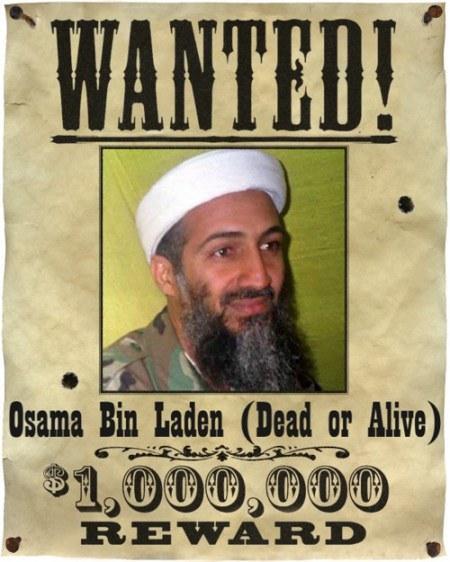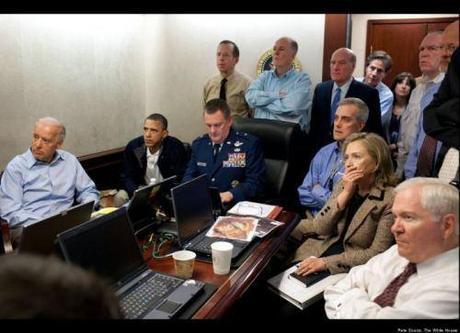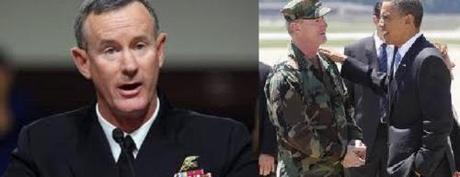
Something really really stinks about that Navy SEALS raid (and assassination) on Osama bin Laden’s compound in Abottabad, Pakistan, on May 2, 2011.
Here are three big reasons why we can’t believe the story we’ve been told.
1. Obama regime’s story about the raid keeps changing:
(See “White House’s Osama Kill Story Keeps Changing,” May 5, 2011)
- Was bin Laden armed or not?
- Did he have a gun battle with the SEALS or not?
- Was one of bin Laden’s wives killed in the raid or not?
- Did Bin Laden use her as a human shield or not?
- Who made the final decision to kill Bin Laden: Obama or the SEALS?
- Was there a live video footage of the raid, or not? The most recent version from the White House was that there wasn’t. If there was no live feed, what were Obama and his White House team watching in this much-publicized Situation Room photo? (Not to mention the fact that graphic artist and author Mara Zebest had analyzed the image below and determined that it’s been “manipulated,” including the insertion of Obama into the image, which means he was never in that situation room!)

The White House captioned this “Situation Room of Osama bin Laden takedown”
2. The Pentagon said it has no records — not one photo, not one video, not even an e-mail — of bin Laden’s death:
(See “Pentagon has no records of Osama bin Laden’s death,” March 28, 2012.)
A year later, in March 2012, in response to repeated (more than 20!) Freedom of Information Act (FOIA) requests by the Associated Press for files about the raid, which the AP had submitted the day after bin Laden’s supposed death, the Pentagon told the AP:
- It could not locate any photographs or video taken during the raid or showing bin Laden’s body.
- It could not find any images of bin Laden’s body on the Navy aircraft carrier where the al-Qaida leader’s body was taken.
- It could not find any death certificate, autopsy report or results of DNA identification tests for bin Laden, or any pre-raid materials discussing how the government planned to dispose of bin Laden’s body if he were killed.
- It said it had searched files at the Pentagon, U.S. Special Operations Command in Tampa, Fla., and the Navy command in San Diego that controls the USS Carl Vinson, the aircraft carrier used in the mission, but could not find any emails about the bin Laden mission or his “Geronimo” code name that were sent or received in the year before the raid by William McRaven, the three-star admiral at the Joint Special Operations Command who organized and oversaw the mission.
- The Pentagon said it also could not find any emails from other senior officers who would have been involved in the mission’s planning.
3. A year later, the Pentagon purged its computers of all files on the raid:
Given the Pentagon’s denial in March 2012 that it has NO, NOTHING, NADA, ZERO record of the bin Laden assassination, it is curious to say the least that on July 8, 2013, the AP reports that an order was given from a “top special operations commander” (Adm. William McRaven) to purge all military files about the Navy SEAL raid on Osama bin Laden’s hideout from Defense Department computers, and to send those files instead to the CIA, where they could be more easily shielded from ever being made public.

From the AP:
The secret move, described briefly in a draft report by the Pentagon’s inspector general, set off no alarms within the Obama administration even though it appears to have sidestepped federal rules and perhaps also the Freedom of Information Act.
An acknowledgement by Adm. William McRaven of his actions was quietly removed from the final version of an inspector general’s report published weeks ago. A spokesman for the admiral declined to comment.
The CIA, noting that the bin Laden mission was overseen by then-CIA Director Leon Panetta before he became defense secretary, said that the SEALs were effectively assigned to work temporarily for the CIA, which has presidential authority to conduct covert operations.
“Documents related to the raid were handled in a manner consistent with the fact that the operation was conducted under the direction of the CIA director,” agency spokesman Preston Golson said in an emailed statement. “Records of a CIA operation such as the (bin Laden) raid, which were created during the conduct of the operation by persons acting under the authority of the CIA Director, are CIA records.”
Golson said it is “absolutely false” that records were moved to the CIA to avoid the legal requirements of the Freedom of Information Act.
The records transfer was part of an effort by McRaven to protect the names of the personnel involved in the raid, according to the inspector general’s draft report.
But secretly moving the records allowed the Pentagon to tell The Associated Press that it couldn’t find any documents inside the Defense Department that AP had requested more than two years ago, and could represent a new strategy for the U.S. government to shield even its most sensitive activities from public scrutiny.
“Welcome to the shell game in place of open government,” said Thomas Blanton, director of the National Security Archive, a private research institute at George Washington University. “Guess which shell the records are under. If you guess the right shell, we might show them to you. It’s ridiculous.”
McRaven’s directive sent the only copies of the military’s records about its daring raid to the CIA, which has special authority to prevent the release of “operational files” in ways that can’t effectively be challenged in federal court. The Defense Department can prevent the release of its own military files, too, citing risks to national security. But that can be contested in court, and a judge can compel the Pentagon to turn over non-sensitive portions of records.
Under federal rules, transferring government records from one executive agency to another must be approved in writing by the National Archives and Records Administration. There are limited circumstances when prior approval is not required, such as when the records are moved between two components of the same executive department. The CIA and Special Operations Command are not part of the same department.
The Archives was not aware of any request from the U.S. Special Operations Command to transfer its records to the CIA, spokeswoman Miriam Kleiman said. She said it was the Archives’ understanding that the military records belonged to the CIA, so transferring them wouldn’t have required permission under U.S. rules.
Special Operations Command also is required to comply with rules established by the chairman of the Joint Chiefs of Staff that dictate how long records must be retained. Its July 2012 manual requires that records about military operations and planning are to be considered permanent and after 25 years, following a declassification review, transferred to the Archives.
Also, the Federal Records Act would not permit agencies “to purge records just on a whim,” said Dan Metcalfe, who oversaw the U.S. government’s compliance with the Freedom of Information Act as former director of the Justice Department’s Office of Information and Privacy. “I don’t think there’s an exception allowing an agency to say, `Well, we didn’t destroy it. We just deleted it here after transmitting it over there.’ High-level officials ought to know better.”
It was not immediately clear exactly which Defense Department records were purged and transferred, when it happened or under what authority, if any, they were sent to the CIA. No government agencies the AP contacted would discuss details of the transfer. The timing may be significant: The Freedom of Information Act generally applies to records under an agency’s control when a request for them is received. The AP asked for files about the mission in more than 20 separate requests, mostly submitted in May 2011 — several were sent a day after Obama announced that the world’s most wanted terrorist had been killed in a firefight. Obama has pledged to make his administration the most transparent in U.S. history.
See also:
- “Families of Navy SEALs killed in downed Chinook blame Obama and military brass,” May 9, 2013.
- “Obama purges US military command (Part 2),” Dec. 4, 2012.
- “Obama purges U.S. military command (Part 1),” Dec. 3, 2012.
H/t FOTM’s beloved pnordman.
~Eowyn

